Solar Power: A Suitcase of Energy for the Tourist
The roots of my love of tourism go back to the distant past, when I was the first year of life - then my parents took me on a hike to the mountains for the first time. Years passed, the geography of travels multiplied, and the hiking set remained approximately the same, except that the equipment was updated: the tents were not tarpaulin, but synthetic (much lighter and more compact), sleeping bags became smaller and warmer, and the trees were bigger ... And only one, the light source was unchanged - a flashlight with a halogen lamp. The batteries ran out quickly, and candles in the tent should never be used, since the tents burn especially quickly. Only with the advent of sufficiently powerful LEDs did the problem begin to be solved.
I grew up, and the love of tourism remained - I managed to sleep in a tent in the Bois de Boulogne, the same tent covered from the wind on the Cote d'Azur of the Mediterranean coast, wrapped up in a sleeping bag in Karelia, slept on a foam on the southern coast of Crimea. And everywhere, one way or another, the question arose of organizing power supply: to charge the camera and camera, to power the laptop to continue working, turn on the music (although I am not a fan of music in nature), charge the screwdriver (I had to work on the road), and provide the camp night lighting. In general, an energy source is always needed.
I have been fond of autonomous energy sources and solar energy for a long time, about which I even wrote a lot of publications, and this year the Mobile Energy Source (MIE Travel) fell into my hands. But since it was a test copy, it would be wrong to write about it right away, but now I have received a serial sample and will gladly share my experience. It will be especially interesting on the eve of the New Year (it turned out to be a great gift for me) and is very important in connection with energy events on the territory of the Crimean peninsula.
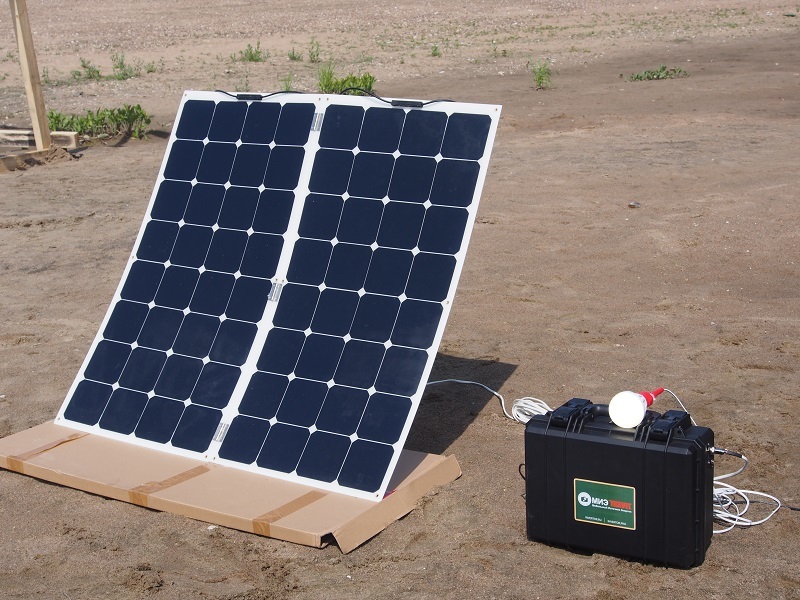
In the summer, when the Aleksey Zemskov’s PLOT project was held and I was able to participate in the implementation of a solar power plant, I saw a test copy of a mobile solar power plant.
Now the serial model of a mobile solar power plant looks like this:

The package bundle is quite rich:
1. 4 LED lamps with a mount
2. charging cable from the cigarette lighter of a car
3. charging cable from solar panels (10 m)
4. cable of direct connection to the battery
5. cable connection to Crystal МИВ (mobile water purification system, I will write about it separately)
6. knife with scabbard and mount on the thigh
7. special camping lighter
The suitcase itself has enviable technical characteristics (taken from the manufacturer’s website ):
Housing made of especially durable plastic
Built-in battery (battery): capacity 36 Ah * 12 V
Voltage inverter: output voltage 220 V, 500 W
MPRT solar controller 12/24 V 15 A ( allows you to charge the battery in cloudy weather).
Recommended solar panels: output voltage 12V or 24V power up to 200 W (purchased separately).
Now we will examine the suitcase from all sides. At each end there are various connectors.
On the one hand:
1. 220 V socket
2. Connector to the terminals of the car (cable 4 in the photo above)
3. 4 connectors for connecting LED lamps
4. regular car cigarette lighter plug
5. general circuit breaker for the entire system
6. 220V inverter switch with operation and overload indicators
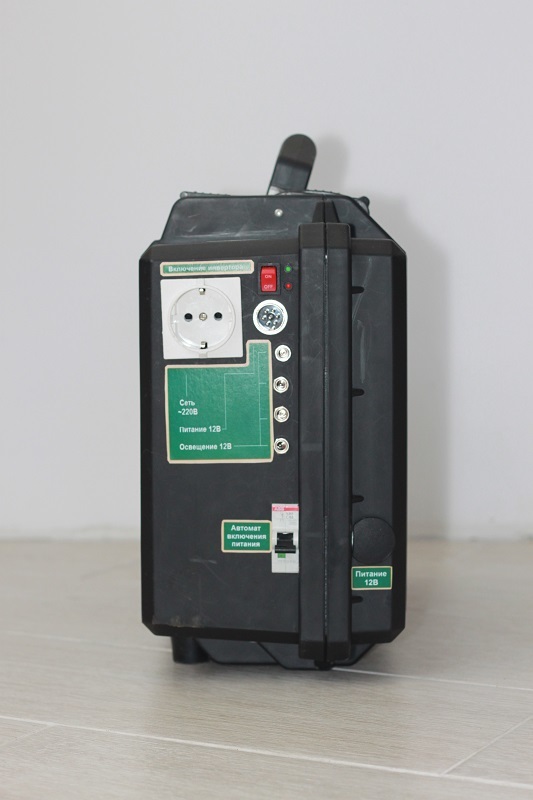
On the other hand:
1. connector for connecting solar panels
2. connector for connecting an external charger (any laptop charger with a suitable one is suitable connector)
3. USB connector
4. vent The

suitcase weighs about 15 kg, is made of sturdy plastic with reliable latches and has a fairly compact size.
The video occasionally appears on the screen on top of the suitcase. It displays the current battery voltage and current balance: if the balance is positive and the built-in battery is charging, then the numbers will be with a positive value. If the energy consumption is greater than the input, then the current value will be negative. It is very curious to observe the change in numbers during the operation of instruments and the bright sun.
It should also be noted the presence of a standard car cigarette lighter. Since each motorist has a lot of equipment, sharpened for use in cars, this connector will certainly not be empty. For example, there are car boilers and kettles, TVs powered by 12V. The camp can be equipped with a video surveillance system by connecting a DVR to this suitcase. But how many devices can be powered if you do not start the car at the same time?
I mentioned above that the cable for connecting to the car’s cigarette lighter is included in the package. This not only allows you to recharge the built-in battery on the go, but also use the inverter, equipping the machine with a 220V outlet. I once watched how they used a multicooker on the road (power 350 W):
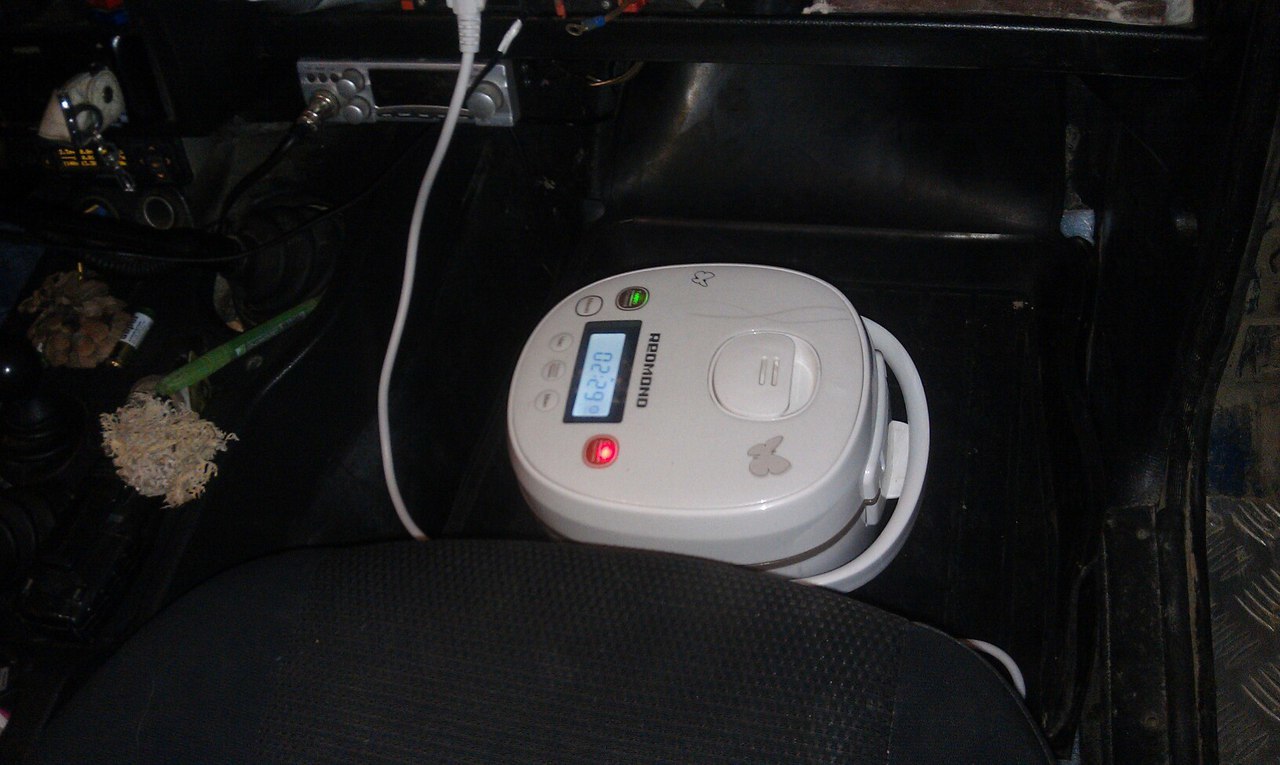
It can be used as a wearable battery with an inverter, as well as a constant source of energy, as we did in the summer in the camp. But for this you need to add solar panels with a power of up to 200 watts, since the 15A solar controller simply can no longer process it. Yes, and the average panel production on a sunny summer day will be about 1.5 kWh and this energy is enough to charge the battery, all the gadgets of the camp will remain. It should be noted that the solar controller has MPPT support, which means that solar panels can be connected in series for a higher voltage, which generally increases the efficiency of the system (less current, thinner wires, less loss, the ability to charge in ambient light). You can choose any solar batteries, but with a glass coating they are quite dimensional and heavy, and the manufacturer offers a compacta dual solar panel - its assembly thickness does not exceed 4 centimeters - this is in the widest place and only because of the metal leg. The entire kit fits easily even in the boot of a compact car. I transported it to the Mitsubishi Colt.

For the sake of experiment, I tried to start a car from this suitcase. To be honest, the car stood in the cold all night, the battery was removed and the suitcase was connected. What came out of this video:
Laptops, phones and cameras were charging properly, but it was curious how the suitcase would transfer work with a power tool. The tests began with a jigsaw and a grinder:
The video clearly demonstrates the operation of power tools and self-reloading the suitcase even after overloading. In the case of the grinder, the question was solved simply: less pressure and careful work with engine speeds allowed, in the end, to cut the sheet, and then the reinforcement.
Campaigns sometimes happen at a noticeable distance from civilization and for quite a long time, so there was an idea to start a bread machine from a suitcase, because it is much easier to bake bread on the spot than to go to the nearest village every few days for fresh bread. I have a bread machine Moulinex Uno with a declared power of 700 watts. Let me remind you that the Mikroart MIE suitcase is equipped with a 500 W inverter. The experiment came out interesting. While the heater was heating up in the bread machine, the inverter periodically went into overload, but after a moment it turned on and the bread machine continued to work. When the heater heated up and the power consumption decreased slightly, the inverter stopped turning off. It must be warned that during baking (3 hours) the baker consumes about 600-650 Wh; that is, the sun should shine very well in order to replenish the energy in the batteries, which is only 432 Wh * if the batteries are fully landed. Therefore, you must either connect the suitcase to the car battery, or adjust the start of baking to clear and sunny weather, so that the solar panels work with might and main.
Using a wattmeter, I recorded the power at which the inverter went into overload: 539 watts.
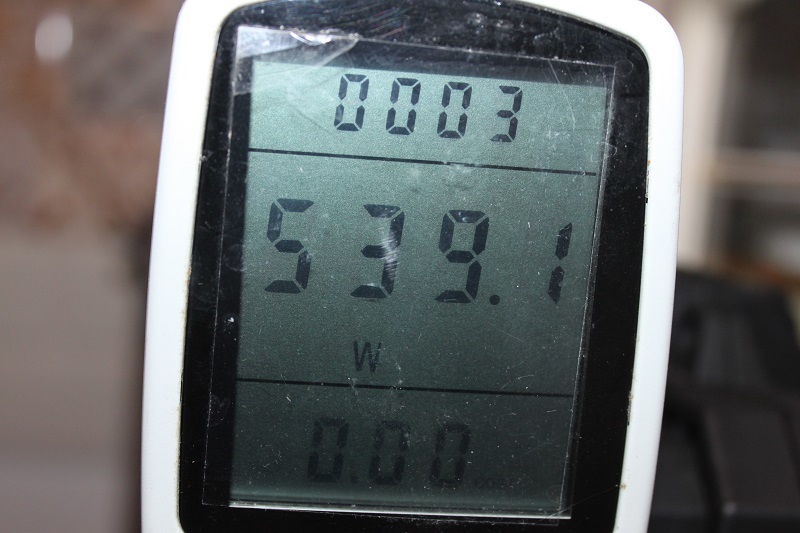
Conclusion
In general, the device proved to be very stable and productive: the power supply of tools and devices is quite sufficient for the traveling option, several charging methods will not leave without electricity, and the rich equipment will allow you to start the car, light the camp, light a fire, and meat for cut the barbecue (do not forget about the turbo lighter and knife). I believe that a set of a suitcase and thin solar panels will replenish my camping belongings without much damage to the trunk space, and the issue of energy supply will be removed for a long time.
Finally, a few photos of the summer operation of this mobile power station. Complete travel kit:
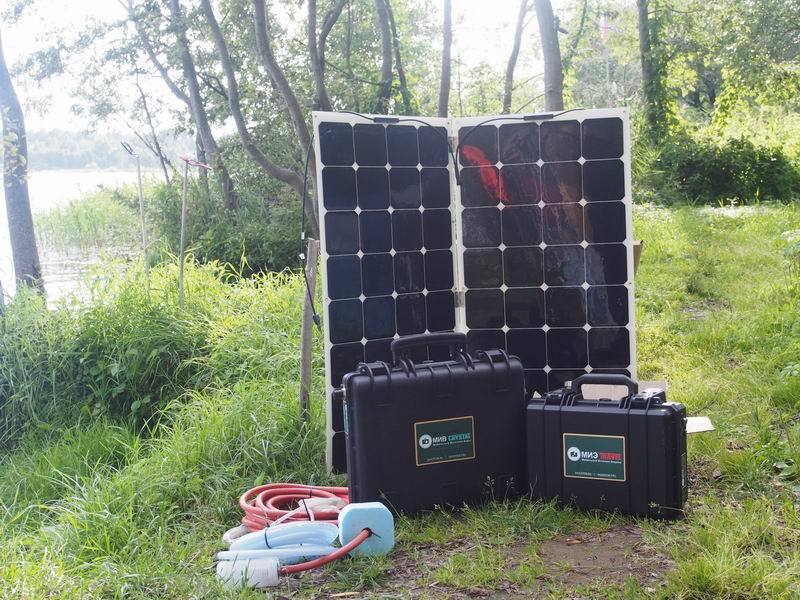
Kit in operation:

View from the water to the camp:
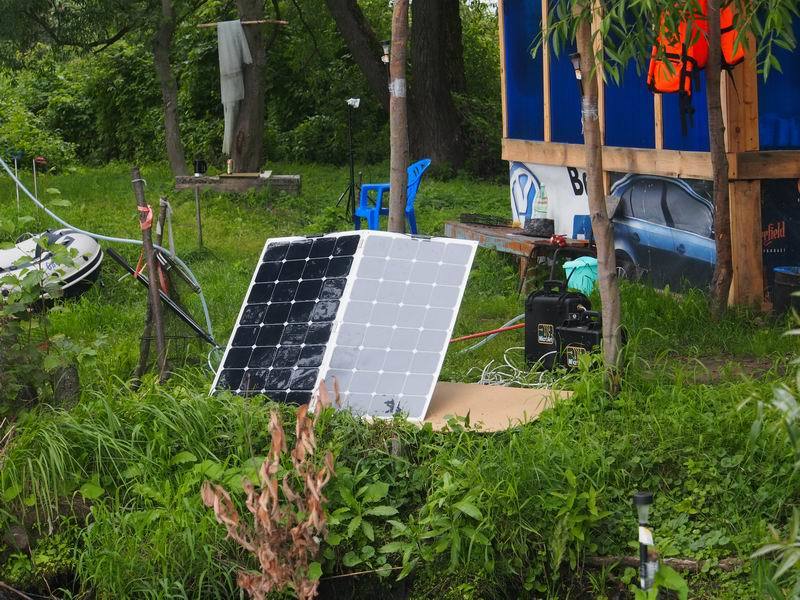
I grew up, and the love of tourism remained - I managed to sleep in a tent in the Bois de Boulogne, the same tent covered from the wind on the Cote d'Azur of the Mediterranean coast, wrapped up in a sleeping bag in Karelia, slept on a foam on the southern coast of Crimea. And everywhere, one way or another, the question arose of organizing power supply: to charge the camera and camera, to power the laptop to continue working, turn on the music (although I am not a fan of music in nature), charge the screwdriver (I had to work on the road), and provide the camp night lighting. In general, an energy source is always needed.
I have been fond of autonomous energy sources and solar energy for a long time, about which I even wrote a lot of publications, and this year the Mobile Energy Source (MIE Travel) fell into my hands. But since it was a test copy, it would be wrong to write about it right away, but now I have received a serial sample and will gladly share my experience. It will be especially interesting on the eve of the New Year (it turned out to be a great gift for me) and is very important in connection with energy events on the territory of the Crimean peninsula.

In the summer, when the Aleksey Zemskov’s PLOT project was held and I was able to participate in the implementation of a solar power plant, I saw a test copy of a mobile solar power plant.
Now the serial model of a mobile solar power plant looks like this:

The package bundle is quite rich:
1. 4 LED lamps with a mount
2. charging cable from the cigarette lighter of a car
3. charging cable from solar panels (10 m)
4. cable of direct connection to the battery
5. cable connection to Crystal МИВ (mobile water purification system, I will write about it separately)
6. knife with scabbard and mount on the thigh
7. special camping lighter
Photos picking
1. 4 LED lamps with fastening
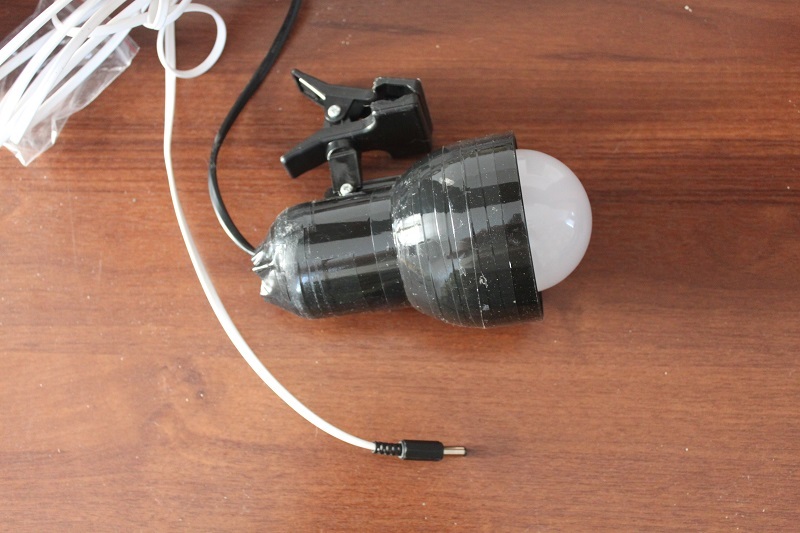
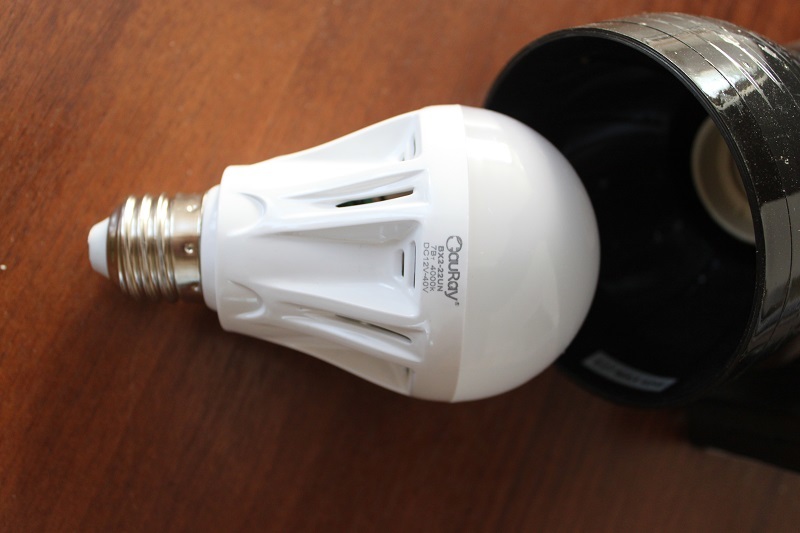
2. charging cable from the car’s cigarette lighter
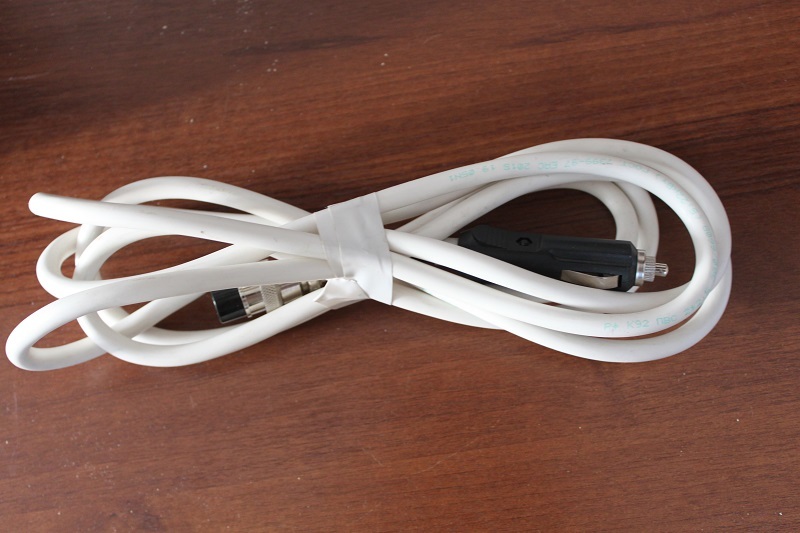
3. charging cable from solar panels (10 m)

4. cable for direct connection to the battery
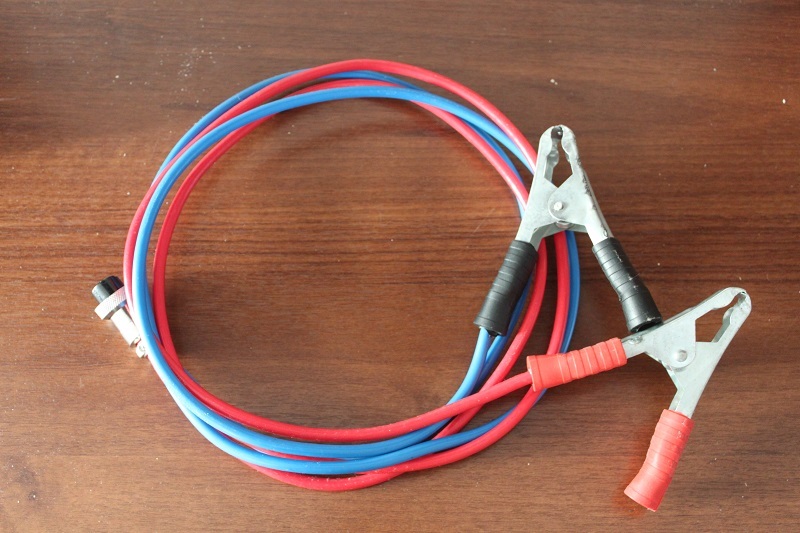
5. cable for connecting to Crystal MiW (mobile water purification system, I will write about it separately)

6. knife with scabbard and mount on the thigh

7. special camping lighter



2. charging cable from the car’s cigarette lighter

3. charging cable from solar panels (10 m)

4. cable for direct connection to the battery

5. cable for connecting to Crystal MiW (mobile water purification system, I will write about it separately)

6. knife with scabbard and mount on the thigh
7. special camping lighter

The suitcase itself has enviable technical characteristics (taken from the manufacturer’s website ):
Housing made of especially durable plastic
Built-in battery (battery): capacity 36 Ah * 12 V
Voltage inverter: output voltage 220 V, 500 W
MPRT solar controller 12/24 V 15 A ( allows you to charge the battery in cloudy weather).
Recommended solar panels: output voltage 12V or 24V power up to 200 W (purchased separately).
Now we will examine the suitcase from all sides. At each end there are various connectors.
On the one hand:
1. 220 V socket
2. Connector to the terminals of the car (cable 4 in the photo above)
3. 4 connectors for connecting LED lamps
4. regular car cigarette lighter plug
5. general circuit breaker for the entire system
6. 220V inverter switch with operation and overload indicators

On the other hand:
1. connector for connecting solar panels
2. connector for connecting an external charger (any laptop charger with a suitable one is suitable connector)
3. USB connector
4. vent The

suitcase weighs about 15 kg, is made of sturdy plastic with reliable latches and has a fairly compact size.
The video occasionally appears on the screen on top of the suitcase. It displays the current battery voltage and current balance: if the balance is positive and the built-in battery is charging, then the numbers will be with a positive value. If the energy consumption is greater than the input, then the current value will be negative. It is very curious to observe the change in numbers during the operation of instruments and the bright sun.
It should also be noted the presence of a standard car cigarette lighter. Since each motorist has a lot of equipment, sharpened for use in cars, this connector will certainly not be empty. For example, there are car boilers and kettles, TVs powered by 12V. The camp can be equipped with a video surveillance system by connecting a DVR to this suitcase. But how many devices can be powered if you do not start the car at the same time?
Photos from 4 sides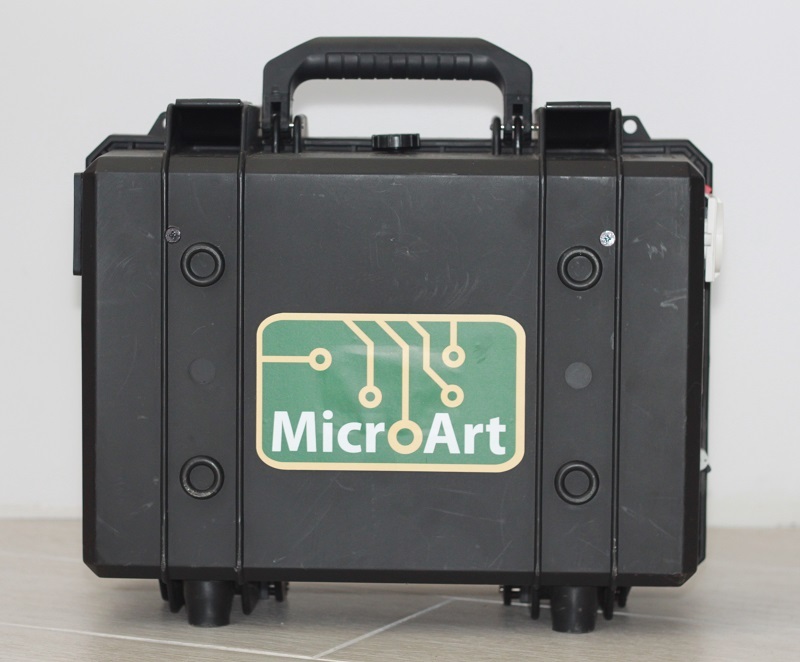







I mentioned above that the cable for connecting to the car’s cigarette lighter is included in the package. This not only allows you to recharge the built-in battery on the go, but also use the inverter, equipping the machine with a 220V outlet. I once watched how they used a multicooker on the road (power 350 W):

It can be used as a wearable battery with an inverter, as well as a constant source of energy, as we did in the summer in the camp. But for this you need to add solar panels with a power of up to 200 watts, since the 15A solar controller simply can no longer process it. Yes, and the average panel production on a sunny summer day will be about 1.5 kWh and this energy is enough to charge the battery, all the gadgets of the camp will remain. It should be noted that the solar controller has MPPT support, which means that solar panels can be connected in series for a higher voltage, which generally increases the efficiency of the system (less current, thinner wires, less loss, the ability to charge in ambient light). You can choose any solar batteries, but with a glass coating they are quite dimensional and heavy, and the manufacturer offers a compacta dual solar panel - its assembly thickness does not exceed 4 centimeters - this is in the widest place and only because of the metal leg. The entire kit fits easily even in the boot of a compact car. I transported it to the Mitsubishi Colt.

For the sake of experiment, I tried to start a car from this suitcase. To be honest, the car stood in the cold all night, the battery was removed and the suitcase was connected. What came out of this video:
Laptops, phones and cameras were charging properly, but it was curious how the suitcase would transfer work with a power tool. The tests began with a jigsaw and a grinder:
The video clearly demonstrates the operation of power tools and self-reloading the suitcase even after overloading. In the case of the grinder, the question was solved simply: less pressure and careful work with engine speeds allowed, in the end, to cut the sheet, and then the reinforcement.
Campaigns sometimes happen at a noticeable distance from civilization and for quite a long time, so there was an idea to start a bread machine from a suitcase, because it is much easier to bake bread on the spot than to go to the nearest village every few days for fresh bread. I have a bread machine Moulinex Uno with a declared power of 700 watts. Let me remind you that the Mikroart MIE suitcase is equipped with a 500 W inverter. The experiment came out interesting. While the heater was heating up in the bread machine, the inverter periodically went into overload, but after a moment it turned on and the bread machine continued to work. When the heater heated up and the power consumption decreased slightly, the inverter stopped turning off. It must be warned that during baking (3 hours) the baker consumes about 600-650 Wh; that is, the sun should shine very well in order to replenish the energy in the batteries, which is only 432 Wh * if the batteries are fully landed. Therefore, you must either connect the suitcase to the car battery, or adjust the start of baking to clear and sunny weather, so that the solar panels work with might and main.
Using a wattmeter, I recorded the power at which the inverter went into overload: 539 watts.

Conclusion
In general, the device proved to be very stable and productive: the power supply of tools and devices is quite sufficient for the traveling option, several charging methods will not leave without electricity, and the rich equipment will allow you to start the car, light the camp, light a fire, and meat for cut the barbecue (do not forget about the turbo lighter and knife). I believe that a set of a suitcase and thin solar panels will replenish my camping belongings without much damage to the trunk space, and the issue of energy supply will be removed for a long time.
Finally, a few photos of the summer operation of this mobile power station. Complete travel kit:
Kit in operation:
View from the water to the camp:
